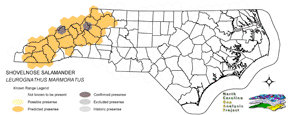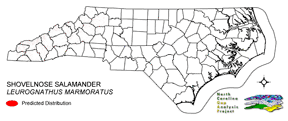
| Taxa: |
| Order: |
| Family: |
| Amphibia |
| Caudata |
| Plethodontidae |
| NatureServe Global Rank: |
| NatureServe State (NC) Rank: |
| G4 |
| S4 |
| Federal Status: |
| NC State Status: |
| --- |
| --- |


| Land Unit |
| US Fish & Wildlife Service |
| US Forest Service |
| US National Park Service |
| US Department of Defense |
| NC State Parks |
| NC University System |
| NC Wildlife Res. Com. |
| NC Forest Service |
| NC Div. of Coastal Mgmt. |
| Local Governments |
| Non-Governmental Org. |
| Other Public Lands |
| Private Lands |
| GAP Status 1-2 |
| All Protected Lands |
| Statewide |
| Hectares |
| 0.00 |
| 10,071.18 |
| 1.89 |
| 3,896.19 |
| 325.98 |
| 2.79 |
| 463.77 |
| 17.46 |
| 0.00 |
| 205.65 |
| 167.76 |
| 0.00 |
| 18,310.59 |
| 5,521.50 |
| 15,143.67 |
| 33,463.26 |
| Acres |
| 0.00 |
| 24,886.42 |
| 4.67 |
| 9,627.69 |
| 805.51 |
| 6.89 |
| 1,146.00 |
| 43.14 |
| 0.00 |
| 508.17 |
| 414.54 |
| 0.00 |
| 45,246.44 |
| 13,643.92 |
| 37,420.82 |
| 82,689.50 |
| % of Dist. on |
| Prot. Lands |
| 0.0 % |
| 66.5 % |
| < 0.1 % |
| 25.7 % |
| 2.2 % |
| < 0.1 % |
| 3.1 % |
| 0.1 % |
| 0.0 % |
| 1.0 % |
| 1.0 % |
| 0.0 % |
| 0.0 % |
| 36.5 % |
| ----- |
| ----- |
| % of Dist. on |
| All Lands |
| 0.0 % |
| 30.1 % |
| < 0.1 % |
| 11.6 % |
| 1.0 % |
| < 0.1 % |
| 1.4 % |
| < 0.1 % |
| 0.0 % |
| 0.6 % |
| 0.5 % |
| 0.0 % |
| 54.7 % |
| 16.5 % |
| ----- |
| ----- |
|
The shovelnose salamander inhabits trout streams in most river drainages of the North Carolina mountains (Martof et al. 1980). This salamander is primarily aquatic and spends much of its time within the banks of small to medium-sized, cool clear upland streams or spring runs (Huheey and Stupka 1967). Rocky bottomed streams are preferred (Wilson 1995). NATURE SERVE GLOBAL HABITAT COMMENTS: Small to medium-sized, cool upland streams or spring runs. Hides under rocks in shallow water, most commonly in riffles. Intolerant of siltation. Attaches eggs to undersides of rocks or logs in main current of stream. |
|
Wilson, L. A. 1995. The Land Manager's Guide to the amphibians and reptiles of the South. Chapel Hill, NC: The Nature Conservancy.
Martof, B. 1962. Some aspects of the life history and ecology of the salamander LEUROGNATHUS. Am. Midl. Nat. 67:1-35. Huheey, J. E., and A. Stupka. 1967. Amphibians and reptiles of Great Smoky Mountains National Park. Univ. Tennessee Press, Knoxville. ix + 98 pp. Martof, B. S. 1963. Leurognathus, L. marmoratus. Cat. Am. Amph. Rep. 3.1-3.2. Behler, J. L., and F. W. King. 1979. The Audubon Society field guide to North American reptiles and amphibians. Alfred A. Knopf, New York. 719 pp. Bruce, R. C. 1985. Larval periods, population structure and the effects of stream drift in larvae of the salamanders DESMOGNATHUS QUADRAMACULATUS and LEUROGNATHUS MARMORATUS in a southern Appalachian stream. Copeia 1985:847-854. Martof, B. S., W. M. Palmer, J. R. Bailey, and J. R. Harrison, III. 1980. Amphibians and reptiles of the Carolinas and Virginia. University of North Carolina Press, Chapel Hill, North Carolina. 264 pp. Mitchell, J. C. 1991. Amphibians and reptiles. Pages 411-76 in K. Terwilliger (coordinator). Virginia's Endangered Species:Proceedings of a Symposium. McDonald and Woodward Publishing Company, Blacksburg, Virginia. |
For more information please contact them at:
NC-GAP Analysis Project
Dept. of Zoology, NCSU
Campus Box 7617
Raleigh, NC 27695-7617
(919) 513-2853
www.basic.ncsu.edu/ncgap